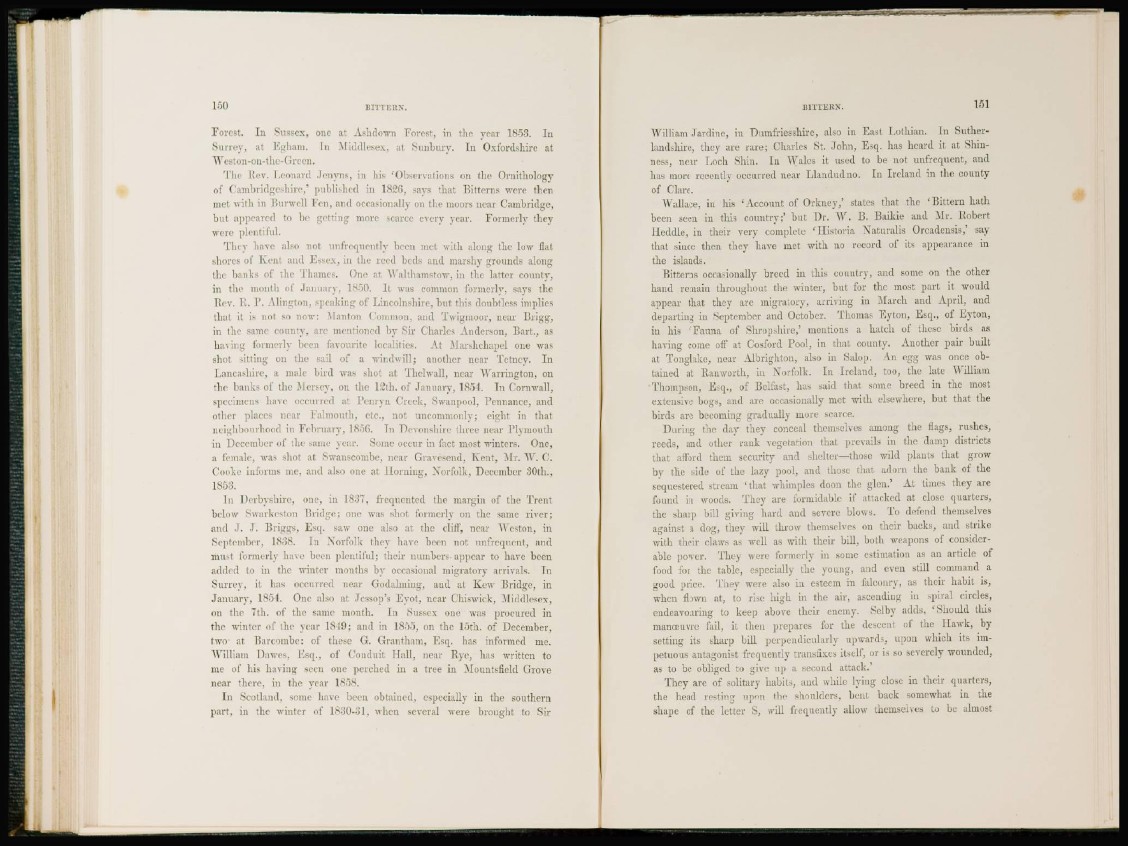
L50 BITTE EN,
Forest. In Sussex, one at Ashdown Forest, in the year 1853. In
Surrey, at Egham. In Middlesex, at Sunbury. In Oxfordshire at
Weston-on-the-( rreen.
The Rev. Leonard Jouyns, in his 'Observations on the Ornithology
of Cambridgeshire,' published in 1826, says that Bitterns were then
met with in Burwell Fen, and occasionally on the moors near Cambridge,
but appeared to be getting more scarce every year. Formerly they
were plentiful.
They have also not unfrequently been met with along the low flat
shores of Kent and Essex, in the reed beds and marshy grounds along
the banks of the Thames. One at Walthamstow, in the latter county,
in the month of January, 1850. It was common formerly, says the
Rev. R. P . Alington, speaking of Lincolnshire, but this doubtless implies
that it is not so now: Manton Common, and Twigmoor, near Brigg,
in the same county, are mentioned by Sir Charles Anderson, Bart., as
having formerly been favourite localities. At Marshchapel one was
shot sitting on 1 he sail of a windwill; another near Tctney. In
Lancashire, a male bird was shot at Thelwall, near Warrington, on
the banks of the Mersey, on the 12th. of January, 1854. In Cornwall,
specimens have occurred at Pcnryn Creek, Swanpool, Pennance, and
other places near Falmouth, etc., not uncommonly; eight in that
neighbourhood in February, 1856. In Devonshire three near Plymouth
in December of the same year. Some occur in fact most winters. One,
a female, was shot at Swanscombe, near Gravesend, Kent, Mr. W. C.
Cooke informs me, and also one at Horning, Norfolk, December 30th.,
1853.
In Derbyshire, one, in 1837, frequented the margin of the Trent
below Swarkeston Bridge; one was shot formerly on the same river;
and J. -1. Briggs, Esq. saw one also at the cliff, near Weston, in
September. 1838. In Norfolk they have been not unfrequent, and
must formerly have been plentiful; their numbers, appear to have been
added to in the winter months by occasional migratory arrivals. In
Surrey, it has occurred near Godalming, and at Kew Bridge, in
January, 1854. One also at Jessop's Eyot, near Chiswick, Middlesex,
on the 7th. of the same month. In Sussex one was procured in
the winter of the year 1849; and in 1855, on the 15th. of December,
two at Barcombe: of these G. Grantham, Esq. has informed me.
William Dawes, Esq., of Conduit 1 [all, near Rye, has written to
me of his Inning seen one perched in a tree in Mountsfield Grove
near there, in the year 185S.
In Scotland, some have been obtained, especially in the southern
part, in the winter of 1830-31, when several were brought to Sir
BITTERN. 151
William Jardine, in Dumfriesshire, also in East Lothian. In Sutherlandshire,
they are rare; Charles St. John, Esq. has heard it at Shinness,
near Loch Shin. In Wales it used to be not unfrequent, aud
has more recently occurred near Llandudno. In Ireland in the county
of Clare.
W allace, in his ; Account of Orkney,' stales that the ' Bittern hath
been seen in this country;' but Dr. W . B. Baikie and Mr. Robert
Heddle, in their very complete ' Ilistoria Naturalis Orcadensis,' say
that since then they have met with no record of its appearance in
the islands.
Bitterns occasionally breed in this country, and some on the other
hand remain throughout the winter, but for the most part it would
appear that they arc migratory, arriving in March and April, and
departing in September and October. Thomas Eyton, Esq., of Eyton,
in his 'Fauna of Shropshire,' mentions a hatch of these birds as
having come off at Cosford Pool, in that county. Another pair built
at Touglake, near Albrighton, also in Salop. An egg was once obtained
at Ran worth, in Norfolk. In Ireland, too, the late William
Thompson, Esq., of Belfast, has said that some breed in the most
extensive bogs, and are occasionally met with elsewhere, but that the
birds are becoming gradually more scarce.
During the day they conceal themselves among the flags, rushes,
reeds, and other rank vegetation that prevails in the damp districts
that afford them security and shelter—those wild plants that grow
by the side of the lazy pool, and those that adorn the bank of the
sequestered stream ' that wdiimples doon the glen.' At times they are
found in woods. They are formidable if attacked at close quarters,
the sharp bill giving hard and severe blows. To defend themselves
against a dog, they will throw themselves on their backs, and strike
with their claws as well as with their bill, both weapons of considerable
power. They were formerly in some estimation as an article of
food for the table, especially the young, and even still command a
good price. They were also in esteem in falconry, as their habit is,
when flown at, to rise high in the air, ascending in spiral circles,
endeavouring to keep above their enemy. Selby adds, 'Should this
manoeuvre fail, it then prepares for the descent of the Hawk, by
setting its sharp bill perpendicularly upwards, upon which its impetuous
antagonist frequently transfixes itself, or is so severely wounded,
as to be obliged to give up a second attack.'
They are of solitary habits, and while lying close in their quarters,
the head resting up"n the shoulders, bent back somewhat in the
shape of the letter S, will frequently allow themselves Lu be almost